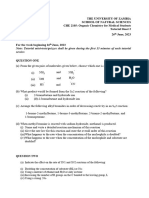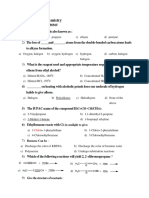Mid Examination of
Uploaded by
Kurnia Tri WijayaMid Examination of
Uploaded by
Kurnia Tri WijayaMID EXAMINATION OF
BASIC OF DRUG SYNTHESIS
Time: 90 minutes April, 15, 2010
1. Show how you might use a nucleophilic substitution reaction of 1-bromopropane to
synthesize each of the following compounds:
OH O SH
a. b. 1-iodopropane c. d.
2. Give the structures and acceptable names for the compounds that would be formed when
1-pentanol is treated with each of the following reagents:
a. Phosphorus tribromide (PBr3) c. Sodium hydride (NaH)
b. Thionyl chloride (SOCl2) d. HBr (conc.), reflux.
3. Write structural formulas for the products that form when 2-methyl-2-butene reacts with
each of the following reagents:
a. HCl c. dilute H2SO4, warm d. Cold concentrated H2SO4
b. Cold concentrated H2SO4, then H2O and heat
4. Starting with the appropriate sulfonic acid and PCl5, or with the appropriate sulfonyl
chloride, show how you would prepare:
a. ethyl p-toluenesulfonate
b. tert-butyl methanesulfonate
5. Starting with ethyne and using retrosynthetic analysis, out line a synthesis of 1-pentyne.
--- Good Luck ---
FINAL EXAMINATION OF
BASIC OF DRUG SYNTHESIS
Time: 90 minutes June, 07, 2010
1. Starting with benzene, out line a synthesis of each of the following:
a. Propylbenzene
b. m-bromonitrobenzene
c. p-chlorobenzenesulphonic acid
2. a. Starting of aniline and assuming that you have 2-aminothiazole available, show how
you would synthesize sulfathiazole.
c. How would you convert sulfathiazole to succinylsulfathiazole?
O O
NH2 NHCCH2CH2COH
H2N S SO2NH SO2NH
S S
N N N
2-aminothiazole sulfathiazole succinysulfalthiazole
3. With 1-propanol as your only organic starting compound, out line a synthesis of 4-
heptanone.
4. Show how each of the following products could be synthesized from butanal:
a. 2-ethyl-2-hexen-1-ol b. 2-ethyl hexanal
5. Give structures for compounds A-D:
H2CrO4 1. CH3MgI H2SO4
Cyclohexanol A (C6H10O) B (C7H14O) C (C7H12)
Acetone 2. H3O+ heat
1.O3
2.Zn,HOAc
D (C7H12O2)
--- Good Luck ---
You might also like
- ACS Review 17 Aldehydes and Ketones - Nucleophilic Addition100% (1)ACS Review 17 Aldehydes and Ketones - Nucleophilic Addition14 pages
- Section-I (Single Correct Choice) : HC CH 1.1eq Nanh Nanh Nanh X XNo ratings yetSection-I (Single Correct Choice) : HC CH 1.1eq Nanh Nanh Nanh X X14 pages
- 12th Chemistry Unit Test Question Paper - Test No 11 Hydroxy Compounds and EthersNo ratings yet12th Chemistry Unit Test Question Paper - Test No 11 Hydroxy Compounds and Ethers3 pages
- CBSE Class 10 Chemistry Worksheet - Carbon and Its Compound90% (10)CBSE Class 10 Chemistry Worksheet - Carbon and Its Compound4 pages
- Section II Q No. 2. Attempt Any Eight Parts Out of TwelveNo ratings yetSection II Q No. 2. Attempt Any Eight Parts Out of Twelve4 pages
- Seth Anandram Jaipuria School Revision Test (2021-22), Class-Xii (Topic - Amines)No ratings yetSeth Anandram Jaipuria School Revision Test (2021-22), Class-Xii (Topic - Amines)2 pages
- STD: Xii Preliminary Examination MARKS: 70 DATE: - / - / - Chemistry Duration: 3 HR General InstructionsNo ratings yetSTD: Xii Preliminary Examination MARKS: 70 DATE: - / - / - Chemistry Duration: 3 HR General Instructions3 pages
- CHE 2105 Tutorial Sheet 2 - 2022-2023 Academic YearNo ratings yetCHE 2105 Tutorial Sheet 2 - 2022-2023 Academic Year3 pages
- 2024 Carbonyl Compounds Tutorial (Students)No ratings yet2024 Carbonyl Compounds Tutorial (Students)6 pages
- CHAPTER 7 - Practice Exercises (ORGANIC CHEM I) - DR. PAHLAVANNo ratings yetCHAPTER 7 - Practice Exercises (ORGANIC CHEM I) - DR. PAHLAVAN4 pages
- CBSE Class 10 Chemistry Worksheet - Carbon and Its CompoundNo ratings yetCBSE Class 10 Chemistry Worksheet - Carbon and Its Compound4 pages
- Term i and II Support Material Chem Xi 2021 (1) ExportNo ratings yetTerm i and II Support Material Chem Xi 2021 (1) Export10 pages
- Section A: Answer All Questions in This SectionNo ratings yetSection A: Answer All Questions in This Section10 pages
- Two Types of Hydrocarbons: Open in Desktop App. Aromatic Compounds (Arene)No ratings yetTwo Types of Hydrocarbons: Open in Desktop App. Aromatic Compounds (Arene)11 pages
- The Total Synthesis of Natural ProductsFrom EverandThe Total Synthesis of Natural ProductsJohn ApSimonNo ratings yet
- Emerging Technologies in Brachytherapy 1st Edition Pieters Ebook All Chapters PDF100% (6)Emerging Technologies in Brachytherapy 1st Edition Pieters Ebook All Chapters PDF62 pages
- Effectiveness of Pressure Ulcer Prevention Strategies For Adult Patients in Intensive Care Units: A Systematic ReviewNo ratings yetEffectiveness of Pressure Ulcer Prevention Strategies For Adult Patients in Intensive Care Units: A Systematic Review13 pages
- Aotearoa New Zealand Autism Guideline Third EditionNo ratings yetAotearoa New Zealand Autism Guideline Third Edition416 pages
- GINA - Pakistan Multi-Sectoral Nutrition Strategy 2018-2025 - 2020-12-07No ratings yetGINA - Pakistan Multi-Sectoral Nutrition Strategy 2018-2025 - 2020-12-074 pages
- PDF Wildlife Toxicology Emerging Contaminant and Biodiversity Issues 1st Edition Ronald J Kendall download100% (2)PDF Wildlife Toxicology Emerging Contaminant and Biodiversity Issues 1st Edition Ronald J Kendall download67 pages
- EPONA Z 150 - 32960 - France - English - 20221215No ratings yetEPONA Z 150 - 32960 - France - English - 2022121515 pages
- Key To Navjeevan Practice Book: Teacher'sNo ratings yetKey To Navjeevan Practice Book: Teacher's20 pages
- User Manual - CHB Charger - EN - V1.2 - 20230614No ratings yetUser Manual - CHB Charger - EN - V1.2 - 202306146 pages
- Health Optimizing Physical Education (HOPE 3) 12: Lesson 1No ratings yetHealth Optimizing Physical Education (HOPE 3) 12: Lesson 14 pages
- Patanjali Yoga Sutra: Chapter 2 - Sadhana PadaNo ratings yetPatanjali Yoga Sutra: Chapter 2 - Sadhana Pada3 pages
- my torturer, my remedy - Chapter 4 - professional_girlkisser - Interview with the Vampire (TV 2022) [Archive of Our Own]No ratings yetmy torturer, my remedy - Chapter 4 - professional_girlkisser - Interview with the Vampire (TV 2022) [Archive of Our Own]1 page
- 40-6515 Automatic Rotating Laser Service Manual: Item Description PagesNo ratings yet40-6515 Automatic Rotating Laser Service Manual: Item Description Pages17 pages
- Manual Flexim Fluxus f72x Series Meters en 10169806No ratings yetManual Flexim Fluxus f72x Series Meters en 10169806238 pages
- BioKube Patent Treatment Process With Smell EliminationNo ratings yetBioKube Patent Treatment Process With Smell Elimination33 pages
- Bioethics (Ngcm108) : Rolando de Guzman Iii RN, RM, Man, Dsped Instructor50% (2)Bioethics (Ngcm108) : Rolando de Guzman Iii RN, RM, Man, Dsped Instructor55 pages

























































































